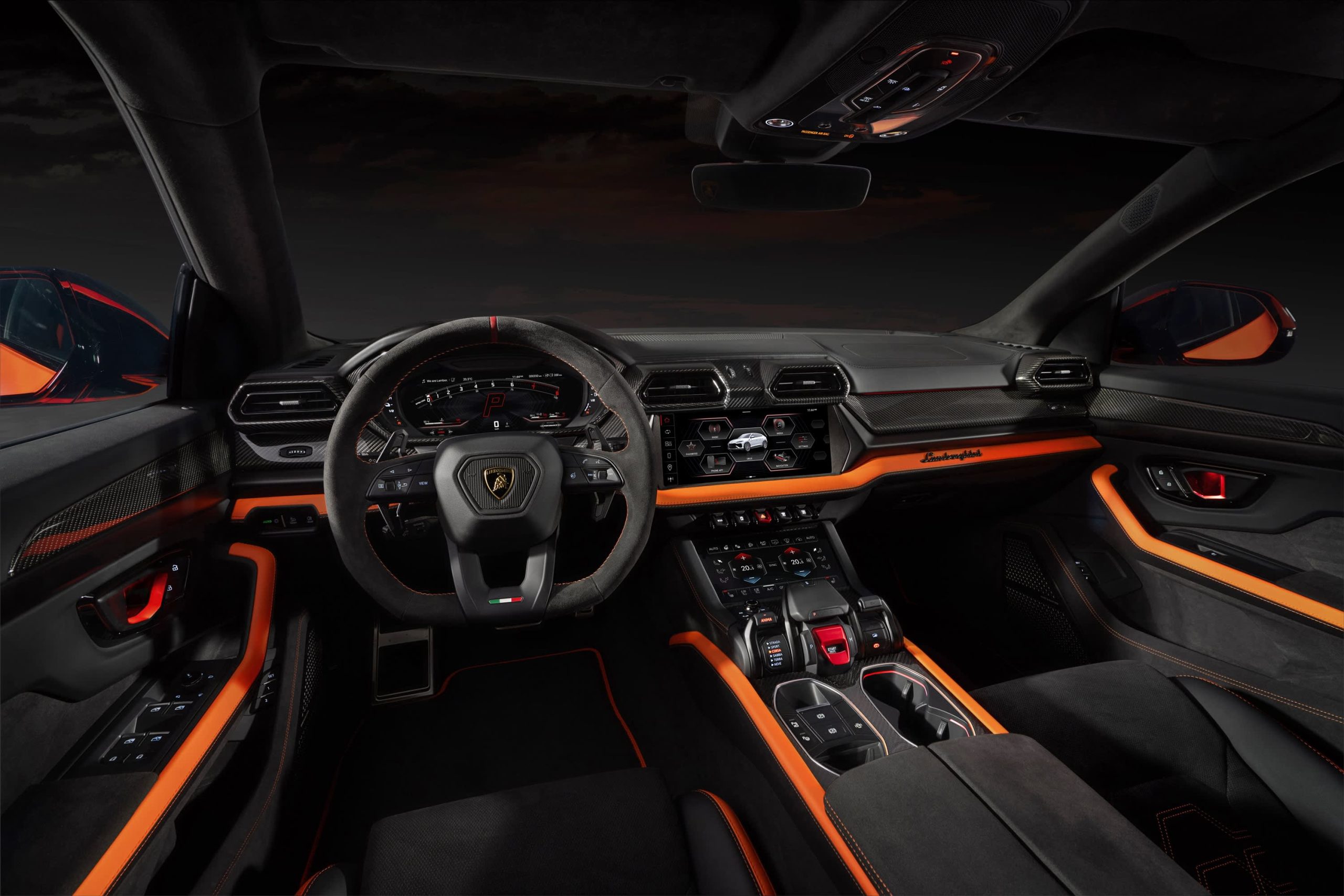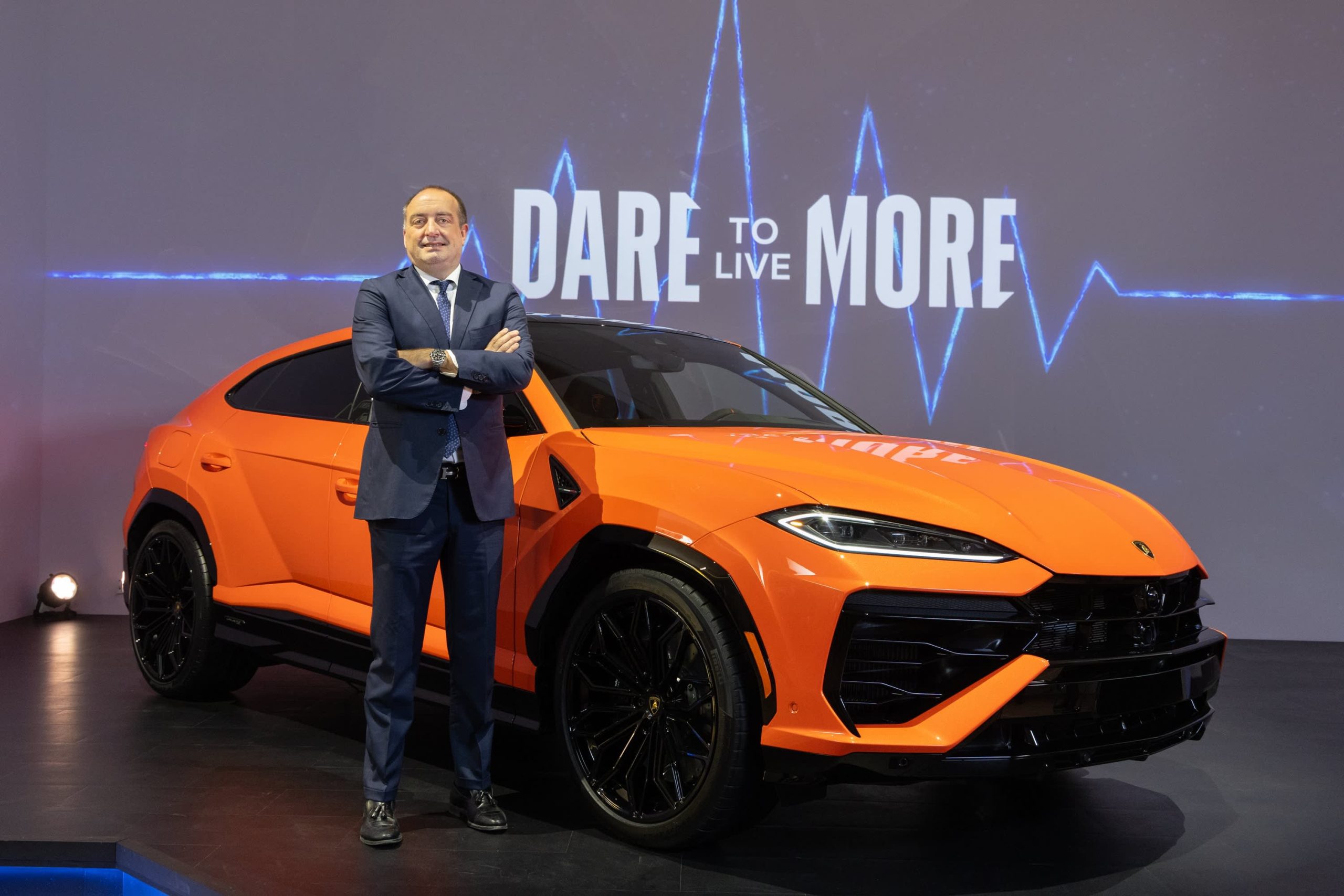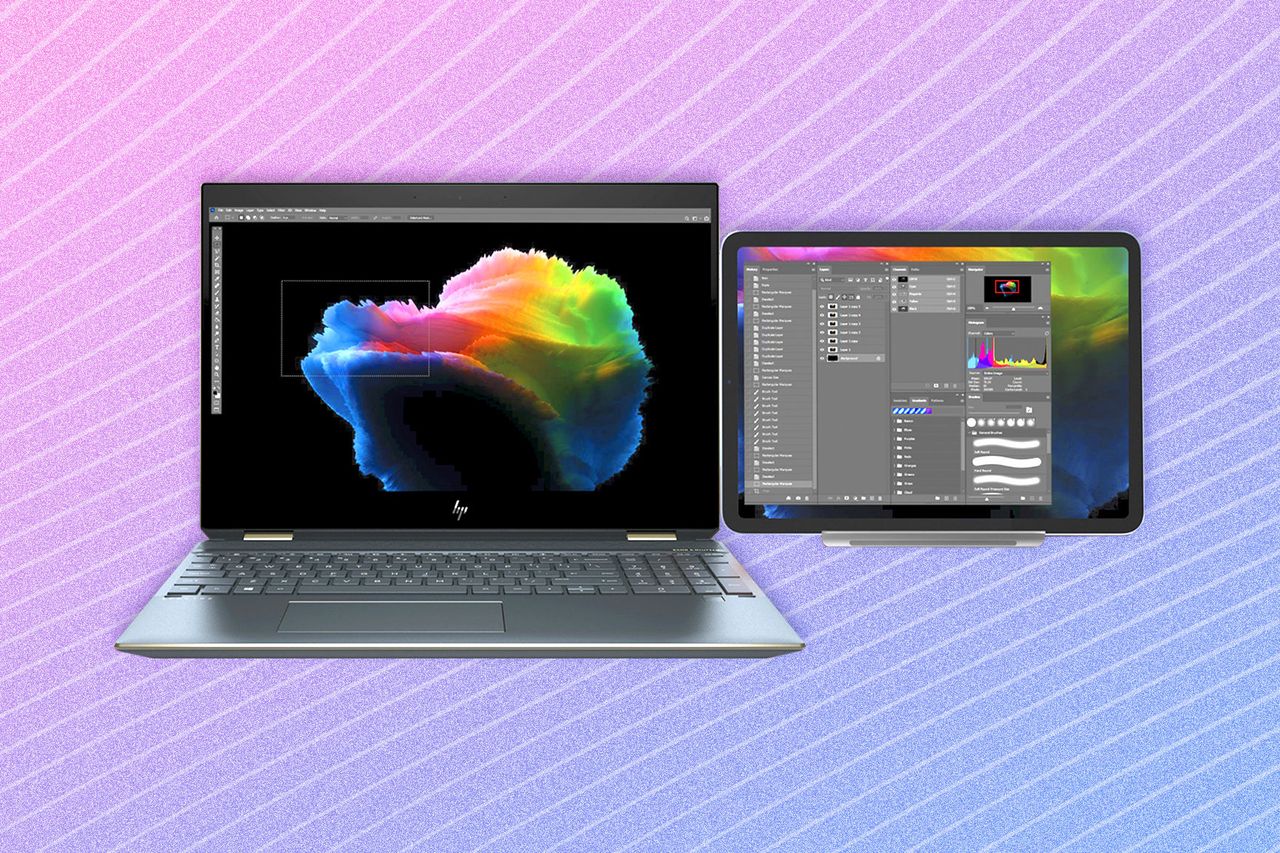Portable Monitors: The Productivity Gadget You Didn’t Know You Needed
Lightweight displays and repurposed tablets can turn any space into a mobile multiscreen office.
Hybrid workers like me tend to bounce around. At home, I’m in whatever spot is quietest. At the office, thanks to Covid-19, I’m hot-desking. And right now, at the Airbnb where I’m enjoying a skiing work vacation, my writing desk is a kitchen table.
Laptops make all this possible, but their relatively small screens tend to cramp productivity. A seminal 2007 study by researchers at the University of Utah found that participants who used a larger display completed tasks 52% faster. A few years later, researchers at Wichita State University concluded that using dual monitors boosted productivity, regardless of screen size.
So if you want to be more effective while working from anywhere, you’re going to want a monitor, and not a heavy desktop one. New lighter-weight portable screens are hitting the market, and there are more ways now to turn old devices into extra displays, too. Here are your main options:
- USB-powered screens often cost as much as traditional monitors, but they are slimmer and lighter, and get their electricity straight from your laptop. Some products include two added side monitors.
- Second-screen software turns your existing tablets (and computers) into extended displays. Apple built it into the Mac and iPad operating systems, and Windows is now compatible with certain Samsung tablets. There’s also an app that lets you choose other devices.
I reviewed four different multiscreen scenarios that made my work tasks easier. Whichever screen or app you choose, be mindful of your laptop’s battery—plug-in displays guzzle power—and your potential neighbours. On a plane, don’t pull out your mega triple-screen setup unless you got lucky and have the row to yourself.
EspressoDisplay v2 Touch-Screen Monitor
The appeal: Big screens, slick design
Price: $669 for the 13-inch, $749 for the 15-inch at espres.so
Compatibility: Most Mac, Windows and Chrome computers
Pros: The Espresso display looks like a superslim iMac. Colours are vivid, and pixels are barely perceptible with the screen’s 1080p resolution. Even the larger of the two models weighs under 1kg, and the magnetically attached stand, sold separately, folds flat to fit in a computer bag.
There are two USB-C ports on the side of the screen: One drives the display connection, while the other can connect to a power brick to charge your laptop, if its own ports are in short supply. The Espresso is touch-enabled, even for Macs, which don’t natively support the capability. You can use two fingers to scroll, or pinch to zoom. The display can also be used in portrait orientation.
Cons: At maximum brightness, the Espresso still isn’t as bright as my M1 MacBook Air, and the screen is reflective, so it can be hard to see in some lighting. You need to download software called EspressoFlow to adjust settings such as brightness and volume. The setup is pricey: Essential accessories such as the stand ($69) and protective case ($39) cost extra. And if your laptop still uses Mini DisplayPort, the older mobile video standard, the adapter costs $40.
Xebec Tri-Screen 2 Laptop System
The appeal: More screens, compact rig
Price: $699 at thexebec.com
Compatibility: Most Mac, Windows and Chrome laptop
Pros: The Tri-Screen 2 adds two thin 10-inch screens, each with a resolution of 1920 x 1200 pixels, to either side of your laptop. An expandable holster attaches to the back of your laptop’s display. A rear kickstand supports the added weight (about 2 pounds). The style is great for smaller spaces. You can even work on the couch if you have a sturdy pillow or something else to prop the kickstand on. As with the Espresso, an additional USB-C port supports laptop charging.
Cons: The screens are small, and you need to tinker with the displays’ resolutions to make text readable. My laptop, a late-2020 M1 MacBook Air, required extra setup: an additional adapter ($70), two dongles and a cable, plus a driver download, because the computer only natively supports one external monitor. Those cables need to be disconnected every time you retract the displays. Alex Levine, the company’s chief executive, said his team is working on larger screens and simpler setups.
Sidecar for Mac and iPad
The appeal: Ready-made for Apple users
Price: Free, but requires a supported iPad and Mac
Compatibility: Macs running MacOS Catalina or later, and an iPad using iPadOS 13 or later
Pros: Sidecar is built into Macs and allows you to use an iPad as an extended display. It works with even the basic 10.2-inch tablet model. Both devices need to be connected to the same Apple ID. Sidecar can work wirelessly over Bluetooth and Wi-Fi, but I recommend using a USB cable for the most stable connection.
The feature provides basic touch interaction. Sidecar even unlocks some limited functionality of the Apple Pencil, so you can select and tap things on the iPad’s screen. Some apps, including Apple’s own Preview, also support drawing and markup.
Cons: There’s no iPad camera support, so you still have to use your Mac’s camera for video calls. The touch gestures are limited to scrolling, copy/cut/paste and undo/redo. You can’t use an iPhone as a second screen. You also can’t customize iPad screen resolution to adjust text size. Sidecar won’t work on older devices or devices that can’t be updated (for instance, some employer-administered devices).
Duet Second-Screen App
The appeal: Works across different platforms
Price: $21 for iOS, $10 for Android/Chromebooks, free for Mac/Windows, pre-installed on select HP computers; $28 a year for premium features; at duetdisplay.com
Compatibility: For iOS, Android, Windows 10, Chromebooks and Mac devices
Pros: Duet is fully platform-agnostic. With a Mac or PC as the primary screen, you can use a variety of other devices, from an Android tablet to an old iMac, as a secondary or mirrored display. Touch-wise, there’s slightly more functionality than Apple’s Sidecar: You can click with a tap, and right-click with a tap-and-hold, or use your finger to pan in Google Street view or virtual real-estate tours. Duet also supports portrait orientation. People with new HP Envy and Spectre models get free access to Duet’s iOS and Android apps.
Cons: A subscription is required for wireless connections, Apple Pencil input, additional touch gestures and remote desktop access. Also, you can’t use the cameras of those connected devices for your video calls.
Coming Soon: Samsung’s Giant Windows-Compatible Tablet
Samsung recently announced new tablets, including a massive 14.6-inch Galaxy Tab S8 Ultra, the biggest tablet on the market to use the high-contrast screen tech found mostly in premium smartphones. Galaxy Tab tablets, starting with last year’s S7 models, can be used as a wireless extended display for Windows 10 computers over a Wi-Fi connection. I haven’t had the chance to test the new Tab yet, but it looks like a promising portable Windows monitor—for around $1540.
Reprinted by permission of The Wall Street Journal, Copyright 2021 Dow Jones & Company. Inc. All Rights Reserved Worldwide. Original date of publication: February 13, 2022.
 Copyright 2020, Dow Jones & Company, Inc. All Rights Reserved Worldwide. LEARN MORE
Copyright 2020, Dow Jones & Company, Inc. All Rights Reserved Worldwide. LEARN MORE
This stylish family home combines a classic palette and finishes with a flexible floorplan
Just 55 minutes from Sydney, make this your creative getaway located in the majestic Hawkesbury region.
The marketplace has spoken and, at least for now, it’s showing preference for hybrids and plug-in hybrids (PHEVs) over battery electrics. That makes Toyota’s foot dragging on EVs (and full speed ahead on hybrids) look fairly wise, though the timeline along a bumpy road still gets us to full electrification by 2035.
Italian supercar producer Lamborghini, in business since 1963, is also proceeding, incrementally, toward battery power. In an interview, Federico Foschini , Lamborghini’s chief global marketing and sales officer, talked about the new Urus SE plug-in hybrid the company showed at its lounge in New York on Monday.

Lamborghini
The Urus SE SUV will sell for US$258,000 in the U.S. (the company’s biggest market) when it goes on sale internationally in the first quarter of 2025, Foschini says.
“We’re using the contribution from the electric motor and battery to not only lower emissions but also to boost performance,” he says. “Next year, all three of our models [the others are the Revuelto, a PHEV from launch, and the continuation of the Huracán] will be available as PHEVs.”
The Euro-spec Urus SE will have a stated 37 miles of electric-only range, thanks to a 192-horsepower electric motor and a 25.9-kilowatt-hour battery, but that distance will probably be less in stricter U.S. federal testing. In electric mode, the SE can reach 81 miles per hour. With the 4-litre 620-horsepower twin-turbo V8 engine engaged, the picture is quite different. With 789 horsepower and 701 pound-feet of torque on tap, the SE—as big as it is—can reach 62 mph in 3.4 seconds and attain 193 mph. It’s marginally faster than the Urus S, but also slightly under the cutting-edge Urus Performante model. Lamborghini says the SE reduces emissions by 80% compared to a standard Urus.
Lamborghini’s Urus plans are a little complicated. The company’s order books are full through 2025, but after that it plans to ditch the S and Performante models and produce only the SE. That’s only for a year, however, because the all-electric Urus should arrive by 2029.

Lamborghini
Thanks to the electric motor, the Urus SE offers all-wheel drive. The motor is situated inside the eight-speed automatic transmission, and it acts as a booster for the V8 but it can also drive the wheels on its own. The electric torque-vectoring system distributes power to the wheels that need it for improved cornering. The Urus SE has six driving modes, with variations that give a total of 11 performance options. There are carbon ceramic brakes front and rear.
To distinguish it, the Urus SE gets a new “floating” hood design and a new grille, headlights with matrix LED technology and a new lighting signature, and a redesigned bumper. There are more than 100 bodywork styling options, and 47 interior color combinations, with four embroidery types. The rear liftgate has also been restyled, with lights that connect the tail light clusters. The rear diffuser was redesigned to give 35% more downforce (compared to the Urus S) and keep the car on the road.
The Urus represents about 60% of U.S. Lamborghini sales, Foschini says, and in the early years 80% of buyers were new to the brand. Now it’s down to 70%because, as Foschini says, some happy Urus owners have upgraded to the Performante model. Lamborghini sold 3,000 cars last year in the U.S., where it has 44 dealers. Global sales were 10,112, the first time the marque went into five figures.
The average Urus buyer is 45 years old, though it’s 10 years younger in China and 10 years older in Japan. Only 10% are women, though that percentage is increasing.
“The customer base is widening, thanks to the broad appeal of the Urus—it’s a very usable car,” Foschini says. “The new buyers are successful in business, appreciate the technology, the performance, the unconventional design, and the fun-to-drive nature of the Urus.”
Maserati has two SUVs in its lineup, the Levante and the smaller Grecale. But Foschini says Lamborghini has no such plans. “A smaller SUV is not consistent with the positioning of our brand,” he says. “It’s not what we need in our portfolio now.”
It’s unclear exactly when Lamborghini will become an all-battery-electric brand. Foschini says that the Italian automaker is working with Volkswagen Group partner Porsche on e-fuel, synthetic and renewably made gasoline that could presumably extend the brand’s internal-combustion identity. But now, e-fuel is very expensive to make as it relies on wind power and captured carbon dioxide.
During Monterey Car Week in 2023, Lamborghini showed the Lanzador , a 2+2 electric concept car with high ground clearance that is headed for production. “This is the right electric vehicle for us,” Foschini says. “And the production version will look better than the concept.” The Lanzador, Lamborghini’s fourth model, should arrive in 2028.
This stylish family home combines a classic palette and finishes with a flexible floorplan
Consumers are going to gravitate toward applications powered by the buzzy new technology, analyst Michael Wolf predicts























